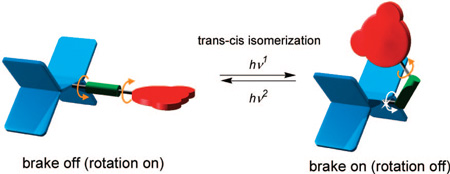| Posted: Jun 04, 2008 | |
Molecular brakes for nanotechnology machines |
|
| (Nanowerk Spotlight) The concept of a 'machine' - a mechanical or electrical device that transmits or modifies energy to perform a certain task - can be extended to the nano world as well. On the nanoscale, the nanomachine components would be molecular structures each designed to perform a specific task which, all taken together, would result in a complex function. Nanoscientists have already built molecular motors, wheels, and gears for powering nanomachines (see for instance: "Nanotechnology reinvents the wheel"). The ability to control nanoscale motors, more specifically, to control the motion of molecular components of such motors, doesn't only involve acceleration and movement but, equally important, deceleration and stopping. So far, the development of a practical braking system for nanomotors remains a challenge. Researchers in Taiwan now have reported development of a light-driven molecular brake that could provide on-demand stopping power for futuristic nanotechnology machines. | |
| "Although we are not the first team trying to develop a light-driven molecular brake (that was demonstrated in 1997: "Toward a Switchable Molecular Rotor. Unexpected Dynamic Behavior of Functionalized Overcrowded Alkenes"), we demonstrated the first example of a room-temperature light-driven molecular brake that displays distinct rates of rotation in the brake-on versus brake-off states" Dr. Jye-Shane Yang tells Nanowerk. "The key progress of our work is to use light as the control unit for 'braking' a rotary motion on the molecular scale." | |
 |
|
| The room-temperature light-driven molecular brake synthesized by the Taiwanese research team consists of a pentiptycene rotator (blue), a 3,5-dinitrophenyl brake (red), and a photoisomerizable ethenyl spacer (green). (Reprinted with permission from American Chemical Society) | |
| Yang, a professor in the Department of Chemistry at National Taiwan University (NTU), collaborated with scientists at NTU and the Institute of Chemistry, Academia Sinica in Taipei. The team published their findings in the May 3, 2008 online edition of Organic Letters, 10 (11), 2279–2282 ("A Pentiptycene-Derived Light-Driven Molecular Brake"). | |
| Previous demonstrations of molecular brakes used chemicals as the control elements. These chemical brakes have the side effect that they generate chemical waste with each operation and could cause a problem with continued operation (pollution at the nanoscale, so to speak). In contrast, light is a clean, fast, and remote-accessible power source. | |
| Yang emphasizes that the stopping power of their light brake is of unprecedented range. The difference in rotation rates between brake-off and brake-on states could be as large as 1 billion-fold, i.e. nine orders of magnitude. | |
| The light-driven molecular brake resembles a tiny four-bladed wheel (a rigid pentiptycene group shown in blue in the illustration below) and contains light-sensitive molecules. The paddle-like structure spins freely when a nanomachine is in motion. Exposing the structure to light changes its shape so that the blades stop spinning, in effect 'putting on the brakes'. The braking power can be turned off and on by altering the wavelength of light exposure. Watch a video illustration of this action: | |
| "Both our experimental and computational results reveal that at 298 °K (approx. 25 °C) rotation of the four-bladed pentiptycene (the rotator) is 'free' in the trans-1 state (brake-off) but is nearly blocked in the cis-1 state (brake-on)" says Yang. | |
| He notes that studies on related braking systems are in progress in their laboratory in order to gain insights into substituent effects on brake performance. The team is also looking into more challenging aspects of braking, such as multi-stage braking power and braking on motors with unidirectional rotation. | |
 By
Michael
Berger
– Michael is author of three books by the Royal Society of Chemistry:
Nano-Society: Pushing the Boundaries of Technology,
Nanotechnology: The Future is Tiny, and
Nanoengineering: The Skills and Tools Making Technology Invisible
Copyright ©
Nanowerk LLC
By
Michael
Berger
– Michael is author of three books by the Royal Society of Chemistry:
Nano-Society: Pushing the Boundaries of Technology,
Nanotechnology: The Future is Tiny, and
Nanoengineering: The Skills and Tools Making Technology Invisible
Copyright ©
Nanowerk LLC
|
Become a Spotlight guest author! Join our large and growing group of guest contributors. Have you just published a scientific paper or have other exciting developments to share with the nanotechnology community? Here is how to publish on nanowerk.com.
